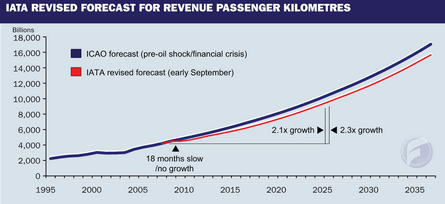European air traffic management can deliver environmental benefits fastest by implementing policies already agreed under the Single European Sky project. That may sound easy, says Civil Air Navigation Services Organisation secretary general Alexander ter Kuile, but it is not.
The reason, ter Kuile says, is that European ATM is too focused on dealing with "institutional issues" and not enough on implementing policy. And he warns that a sharp downturn in airline traffic in Europe may constitute a threat to efficiency improvements that would benefit the environment.
With traffic movements at some European hubs dropping by as much as 10% compared with a year ago, air navigation services providers (ANSP) are seeing their incomes drop, which may make their political masters reluctant to invest in system improvements that could reduce fuel consumption and therefore emissions, CANSO fears.
 |
|---|
© Polly Thisdell |
Airports and lower airspace are experiencing big traffic drops, ter Kuile said in a presentation earlier this month at an air traffic management conference on functional airspace blocks (FAB) organised by HungaroControl in Budapest, but the global economic slowdown has also reduced overflights.
Ter Kuile quoted the UK's NATS as experiencing nearly 2% total traffic drop, Belgocontrol 0.3%, and Spain's AENA 0.6%.
Conference participants released a statement drawing attention to the dire business environment airlines are facing, and called on governments to ensure that all improvements in ATM efficiency that can be made be implemented as soon as possible. They note "the rapidly changing world economy and its impact on the world's airlines", and call for:
- The earliest possible implementation of the airspace efficiencies foreseen in the Single European Sky.
- Early approval and implementation of Single European Sky Package II.
- A re-evaluation of investment programmes to ensure acceleration of efficiencies and cost benefits that can be secured in the short term and deferral of other investments that are jointly agreed as non-essential at this time.
Airline losses this year are expected to continue, and possibly worsen, in 2009, says CANSO, so all possible benefits from improvements approved for the early stages of the Single European Sky programme as identified in the SESAR study should be accelerated.
EUROPEAN OBSESSION
Ter Kuile laments a European obsession with "institutional issues" because ATM in most countries is so close to politics, and pleads for ANSPs to be cleared to implement change. At present, ter Kuile says, the power to achieve beneficial ATM improvement lies 60% in the hands of government and the military, and only 10% is in the hands of the ANSPs. The remaining 30% depends on successful regional co-ordination programmes, he said.
The first policy measure that should be pressed into service, ter Kuile believes, should be the effort to speed gate-to-gate performance by all flights. Routes could be shortened by redesign or the flexible use of airspace, optimising airspace structures, airport arrival and departure procedures and shortening ground movements. He says collaborative decision making could ensure the harmonisation of every movement within the system.
 |
|---|
Eurocontrol is encouraging operators and airports to combine the collaborative decision-making principle with environmental awareness, producing what it has dubbed collaborative environmental management - a strategic process for operational stakeholders to establish an airport environmental partnership. Eurocontrol says implementation guidance should be approved by stakeholders this year.
There is "low hanging fruit", in terms of routeing efficiency, available to be picked, says ter Kuile, but this will not be done without a change of attitude that allows "total institutional reform", enabling the optimisation of cross-border airspace by adopting true FABs in place of nationally sectored airspace design.
The International Air Transport Association, Eurocontrol and CANSO jointly signed a "flight efficiency plan" recently to push for co-ordinated ATM efficiency improvements. They agree the single most urgent infrastructural requirement is the implementation of FABs, which they point out are "required" under the Single Sky legislation. But if ter Kuile's fears are realised, the fixation on "institutional issues" could see their implementation pushed back again.
These airspace blocks, as well as providing opportunities for reduced route lengths, fuel burn and emissions, should also, say the three partners, "provide the opportunity for airspace optimisation around airports which could facilitate more continuous descent approaches from higher up the descent path". So far, 20 European airports are using continuous descent approaches for some approaches, but the SESAR target is for 100 airports by 2013.
Another potential area for ATM efficiency improvement is in the hands of the airlines. Ter Kuile says improved airline flight planning could yield fuel savings of 2% on intra-European routes, since many carriers file the same flightplans automatically for familiar schedules, possibly missing opportunities to optimise their routeing by being unaware of airspace and routeing reorganisation.
 |
|---|
NORWAY EXPERIMENT POINTS TO BENEFITS
The Norwegian air navigation service provider Avinor and Eurocontrol have completed the first phase of real-time simulations to evaluate airspace and traffic flow reorganisation in Oslo's terminal manoeuvring area (TMA). Benefits could include shorter flight times, lower fuel use, fewer people on the ground affected by noise, improved traffic flow and better safety.
From the first quarter of 2011, airlines using the Oslo TMA will fit into redesigned traffic patterns that depend on the use of precision area navigation techniques, using the Point Merge procedure developed by Eurocontrol's Budapest Experimental Centre. This will be combined with a new Barco arrival manager for incoming traffic to Oslo Gardermoen.
Point Merge, says Eurocontrol, "aims at improving and harmonising arrival operations with existing technology including P-RNAV". The Experimental Centre's operational expert François Vergne says: "Point Merge enables, in particular, continuous descent approach even under high traffic load, with a potential average fuel saving of 100kg [220lb] per aircraft in the TMA. In addition, it is a key building block for longer-term developments in the context of SESAR, such as 4D trajectory management."
The simulations are part of Avinor's Oslo advanced sectorisation and automation project (ASAP), aimed at ensuring adequate capacity for future traffic growth in the Oslo area. Geir Gillebo, ASAP project manager, says: "Within the Oslo TMA, the use of Point Merge with associated working methods and tools would enable a capacity increase of up to 30%. It would also allow the use of continuous descent approach and continuous climb departures that will reduce carbon dioxide emission."
Eurocontrol says it is also supporting the Irish and Italian ANSPs in their assessment of Point Merge.
Source: Flight International



















